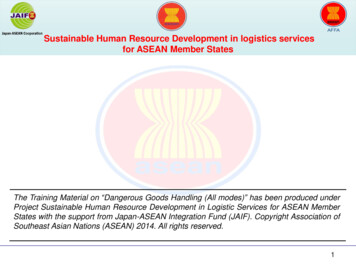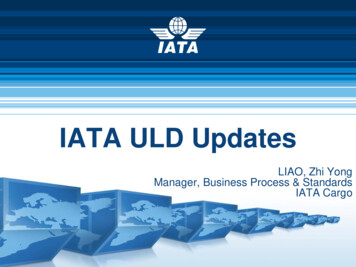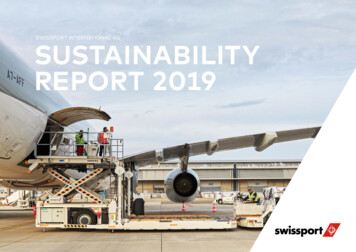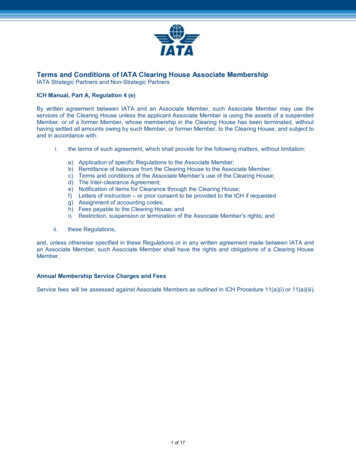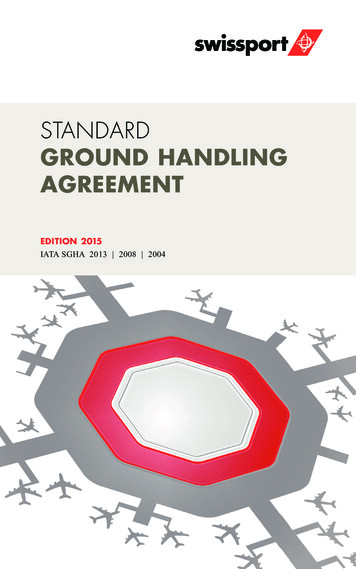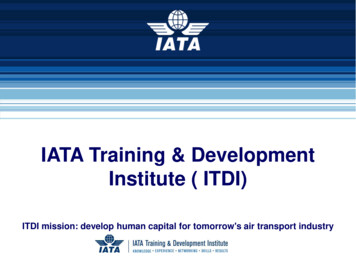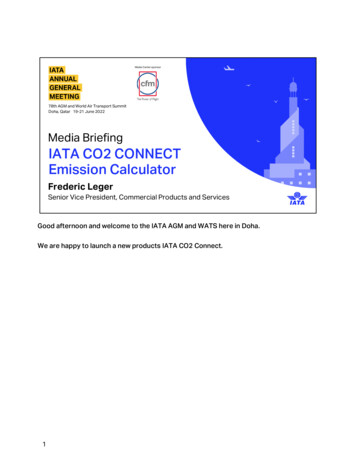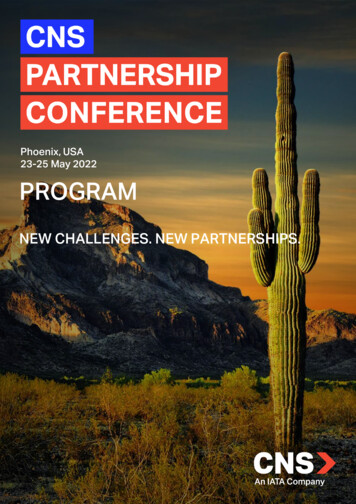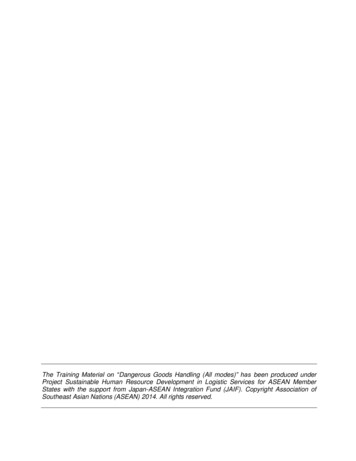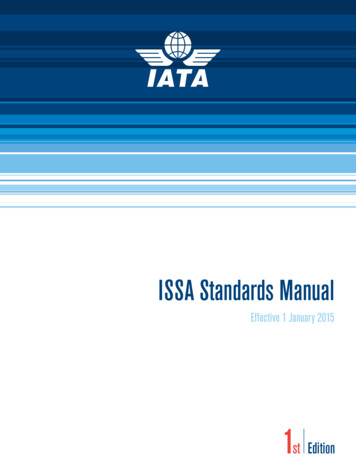
Transcription
ISSA Standards ManualEffective 1 January 20151st Edition
NOTICEDISCLAIMER. The information contained in thispublication is subject to constant review in the lightof changing government requirements and regulations. No subscriber or other reader should act onthe basis of any such information without referringto applicable laws and regulations and/or withoutseeking appropriate professional advice. Althoughevery effort has been made to ensure accuracy, theInternational Air Transport Association shall not beheld responsible for any loss or damage causedby errors, omissions, misprints or misinterpretationof the contents hereof. Furthermore, the International Air Transport Association expressly disclaimsany and all liability to any person or entity, whethera purchaser of this publication or not, in respect ofanything done or omitted, and the consequencesof anything done or omitted, by any such person orentity in reliance on the contents of this publication. International Air Transport Association. All RightsReserved. This publication, in whole or in part, maysolely be used for the application and execution ofthe ISSA Program, and for no other purpose. In anyevent, no part of this publication may in any way beincorporated, distributed or otherwise used for anypurpose that is commercial in character, whetheror not for profit. No part of this publication may bereproduced, recast, reformatted or transmitted inany form by any means, electronic or mechanical, including photocopying, recording or any informationstorage and retrieval system, without prior writtenpermission from:Senior Vice-PresidentSafety and Flight OperationsInternational Air Transport Association800 Place VictoriaP.O. Box 113Montreal, QuebecCANADA H4Z 1M1ISSA Standards ManualISBN 978-92-9252-488-3 2014 International Air Transport Association. All rights reserved.Montreal—Geneva
Approval PageStepReviewed by:Recommended by:Approved by:NameSerkan SimitciogluHead, IOSASafety and Flight OperationsCatalin CotrutDirector, Audit ProgramsSafety and Flight OperationsKevin L. HiattSenior Vice President,Safety and Flight OperationsISSA Standards Manual, Edition 1, January 2015DateJanuary 2015January 2015January 20151
ISSA Standards ManualINTENTIONALLY LEFT BLANK2ISSA Standards Manual, Edition 1, January 2015
Table of ContentsIntroduction . INT 11Purpose . INT 12Structure . INT 13Sources for ISSM Standards and Recommended Practices (ISARPs).INT 14Applicability of ISARPs . INT 15Explanation of ISARPs. INT 26Guidance Material. INT 37Operational Assessment. INT 48Safety Management Systems (SMS). INT 59ISSA Documentation System. INT 510English Language . INT 611Manual Revisions . INT 612Conflicting Information . INT 613Definitions . INT 614Authority. INT 6Section 1 — Organization and Management System (ORG) .ORG 11Management and Control . ORG 11.1Organization and Accountability . ORG 11.2Management Commitment . ORG 41.3Accountabilities, Authorities and Responsibilities.ORG 51.4Communication . ORG 61.5Management Review. ORG 61.6Provision of Resources. ORG 71.7(Intentionally Open) . ORG 81.8(Intentionally Open) . ORG 8ISSA Standards Manual, Edition 1, January 2015TOC 3
ISSA Standards Manual2Documentation and Records . ORG 82.1Documentation System . ORG 82.2Records System . ORG 103Safety Management . ORG 103.1Safety Risk Management . ORG 103.2Safety Assurance . ORG 133.3Flight Safety Analysis Program . ORG 143.4Quality Assurance Program. ORG 173.5Outsourcing Quality Control . ORG 193.6Product Quality Control . ORG 194Emergency Response . ORG 204.1Emergency Response Plan . ORG 20Table 1.1–Documentation System Specifications .ORG 22Section 2 — Flight Operations (FLT) .FLT 11Management and Control. FLT 11.1(Intentionally Open). FLT 11.2State Requirements . FLT 11.3–1.6(Intentionally Open). FLT 31.7Operations Manual. FLT 31.8–1.10(Intentionally Open). FLT 31.11(Intentionally Open). FLT 32Training and Qualification. FLT 32.1Training and Evaluation Program.FLT 32.2Training Elements . FLT 42.3Line Qualification. FLT 9TOC 4ISSA Standards Manual, Edition 1, January 2015
Table of Contents3Line Operations. FLT 103.1(Intentionally Open). FLT 103.2(Intentionally Open). FLT 103.3Flight Crew Qualifications. FLT 103.4–3.8(Intentionally Open). FLT 103.9Ground Handling . FLT 103.10Airspace Rules . FLT 113.11In-flight Operations. FLT 114Operations Engineering Specifications .FLT 134.1–4.2(Intentionally Open). FLT 134.3Aircraft Systems and Equipment Specifications .FLT 134.4Cargo Compartment Systems and Equipment Requirements.FLT 14Table 2.1–(Intentionally Open). FLT 15Table 2.2–Operations Manual (OM) Content Specifications .FLT 16Table 2.3–(Intentionally Open). FLT 18Table 2.4–(Intentionally Open). FLT 19Table 2.5–Route and Airport Knowledge Requirements .FLT 20Table 2.6–Elements of an Advanced Qualification Program (AQP) or Alternative Training andQualification Program (ATQP) . FLT 21Table 2.7–Requirements of an Advanced Qualification Program (AQP) or Alternative Training andQualification Program (ATQP) . FLT 23Section 3 — Operational Control and Flight Dispatch (DSP) .DSP 11Management and Control. DSP 41.1–1.2(Intentionally Open). DSP 41.3Authorities and Responsibilities . DSP 41.4–1.6(Intentionally Open). DSP 81.7Operations Manual. DSP 8ISSA Standards Manual, Edition 1, January 2015TOC 5
ISSA Standards Manual2Training and Qualification. DSP 82.1Training and Evaluation Program. DSP 82.2Training Elements . DSP 93Line Operations. DSP 93.1–3.5(Intentionally Open). DSP 93.6Flight Monitoring and In-flight Management .DSP 9Table 3.1–Operational Control Personnel. DSP 10Table 3.2–Operations Manual (OM) Content Specifications .DSP 12Table 3.3–(Intentionally Open). DSP 14Table 3.4–(Intentionally Open). DSP 15Table 3.5–Competencies of Operational Control .DSP 16Section 4 — Aircraft Engineering and Maintenance (MNT) .MNT 11Management and Control . MNT 11.1–1.2(Intentionally Open) . MNT 11.3Maintenance Program . MNT 11.4–1.6(Intentionally Open) . MNT 31.7Maintenance Management Manual.MNT 32Maintenance Control. MNT 52.1Control System . MNT 52.2Maintenance Planning . MNT 52.3Parts Installation . MNT 52.4Deferred Maintenance . MNT 62.5Continuing Airworthiness . MNT 62.6Repairs and Modifications. MNT 62.7Defect Recording and Control. MNT 6TOC 6ISSA Standards Manual, Edition 1, January 2015
Table of Contents3Technical Records . MNT 63.1Aircraft Maintenance Records. MNT 63.2Aircraft Technical Log (ATL) . MNT 73.3(Intentionally Open) . MNT 73.4Airworthiness Directives . MNT 74Maintenance Organizations . MNT 74.1Approval. MNT 84.2(Intentionally Open) . MNT 84.3Quality Assurance. MNT 84.4(Intentionally Open) . MNT 94.5Training Program . MNT 94.6–4.8(Intentionally Open) . MNT 104.9Procedures Manual. MNT 104.10Maintenance Release . MNT 12Table 4.1–Maintenance Program Specifications .MNT 13Table 4.2–(Intentionally Open) . MNT 14Table 4.3–Maintenance Management Manual Content Specifications.MNT 15Table 4.4–(Intentionally Open) . MNT 16Table 4.5–ETOPS Maintenance Program Specifications .MNT 17Table 4.6–Aircraft Technical Log (ATL) Specifications .MNT 18Table 4.7–Quality Assurance Program Specifications and Control Processes.MNT 19Table 4.8–(Intentionally Open) . MNT 20Table 4.9–Maintenance Procedures Manual Content Specifications .MNT 21ISSA Standards Manual, Edition 1, January 2015TOC 7
ISSA Standards ManualSection 5 — Cabin Operations (CAB) .CAB 11Management and Control. CAB 11.1–1.5(Intentionally Open). CAB 11.6Operations Manual. CAB 12Training and Qualification. CAB 12.1Training Program . CAB 13Line Operations. CAB 33.1(Intentionally Open). CAB 33.2Cabin Crew Policies and Procedures .CAB 3Table 5.1–Operations Manual Content Specifications .CAB 5Section 6 — Ground Handling Operations (GRH) .GRH 11Management and Control . GRH 11.1–1.5(Intentionally Open) . GRH 11.6Operational Manuals . GRH 12Training and Qualification . GRH 22.1Training Program. GRH 22.2Program Elements. GRH 23Ground Handling Operations . GRH 43.1–3.2(Intentionally Open) . GRH 43.3Load Control . GRH 43.4Aircraft Loading . GRH 44Special Aircraft Ground Handling Operations .GRH 44.1Aircraft Fueling . GRH 44.2Aircraft De-/Anti-icing. GRH 5TOC 8ISSA Standards Manual, Edition 1, January 2015
Table of ContentsSection 7 — Cargo Operations (CGO) .CGO 11Management and Control . CGO 11.1–1.5(Intentionally Open) . CGO 11.6Operational Manuals . CGO 12Training and Qualification. CGO 22.1Training Program. CGO 22.2Program Elements. CGO 23Acceptance and Handling. CGO 43.1General Cargo. CGO 43.2Dangerous Goods . CGO 4Table 7.1–Operations Manual Content Specifications .CGO 5Section 8 — Security Management (SEC) .SEC 11Management and Control. SEC 11.1Management System . SEC 11.2Security Program . SEC 11.3–1.6(Intentionally Open). SEC 21.7Security Manual . SEC 22Training and Qualification. SEC 32.1Training Program . SEC 3ISSA Standards Manual, Edition 1, January 2015TOC 9
ISSA Standards ManualINTENTIONALLY LEFT BLANKTOC 10ISSA Standards Manual, Edition 1, January 2015
Introduction1PurposeThe ISSA Standards Manual (ISSM) is published in order to provide the standards, recommendedpractices (ISARPs), associated guidance material and other supporting information necessary for anoperator to successfully prepare for an assessment.The ISSM may also be used as a guide for any operator desiring to structure its operationalmanagement and control systems in conformity with the latest industry operational practices.The ISSM is the sole source of assessment criteria to be utilized by auditors when conducting anassessment against the ISARPs.2StructureThe ISSM is organized as follows:Section 1 Organization and Management System (ORG);Section 2 Flight Operations (FLT);Section 3 Operational Control and Flight Dispatch (DSP);Section 4 Aircraft Engineering and Maintenance (MNT);Section 5 Cabin Operations (CAB);Section 6 Ground Handling Operations (GRH);Section 7 Cargo Operations (CGO);Section 8 Security Management (SEC).Each section in this Manual has been assigned an associated 3-letter identifier (in parenthesesabove). The reference number for every standard or recommended practice within a section willinclude the specific 3-letter identifier for that section.3Sources for ISSM Standards and Recommended Practices (ISARPs)The safety and security requirements published in the Annexes to the Convention on InternationalCivil Aviation (ICAO Annexes) are the primary source for specifications contained the ISARPs. Safetyand security requirements in the ICAO Annexes used as the basis for ISARPs are those that areapplicable either directly or indirectly to the air operator.4Applicability of ISARPsApplicability GuidanceThe applicability of individual standards or recommended practices is always determined by theauditor. As a means to assist with the interpretation of individual application, many ISARPs beginwith a conditional phrase as described below.Systemic ApplicabilityWhen making a determination as to the applicability of individual ISARPs, it is important to take intoaccount operations (relevant to the individual standard or recommended practice) that areconducted, not only at the home station, but at all stations and other locations throughout theoperator's entire system.Aircraft ApplicabilityThe ISARPs as published in this version of the ISSM are applicable only for the assessment of anoperator that meets the eligibility criteria below: Commercial passenger and/or cargo operations; Aircraft with one or more turbine powered and/or multiple reciprocating engines; One- or two-pilot operations;ISSA Standards Manual, Edition 1, January 2015INT 1
ISSA Standards Manual IFR and/or VFR operations; Aircraft below 5,700 Kg MTOW;Note: Aircraft above 5,700 Kg MTOW will be eligible for one ISSA initial assessment, afterwards theoperator needs to pursue an IOSA registration initial audit to stay on an IATA Audit registry.ISARPs may not be applied or used for the assessment of operations that are conducted with: LUFUDIW ZLWK VLQJOH UHFLSURFDWLQJ HQJLQHV Helicopters; Seaplanes Q\ RSHUDWRU ZKR LV FXUUHQWO\ RQ WKH ,26 5HJLVWU\ 2SHUDWRUV ZLWK QR DLUFUDIW RQ WKH 2& RQO\ ZHW OHDVH RSHUDWLRQV During an assessment, ISARPs are applied only to those aircraft that are of the type authorized in theAir Operator Certificate (AOC) (or equivalent document) and utilized in commercial passenger and/orcargo operations. Certain ISARPs are also applicable to non-commercial operations, and suchapplication is indicated in a note that is part of the standard or recommended practice.Other owned or leased aircraft that are not of the type authorized in the AOC and/or not utilized incommercial air transport operations will not be evaluated during an assessment. However, theexistence of such aircraft will be referenced with an explanation in the ISSA Assessment Report(IAR).5Explanation of ISARPsISARPs contained in this manual have been developed solely for use under the ISSA program andcontain the operational criteria upon which the assessments are based. ISARPs are not regulations.StandardsISSA Standards are specified systems, policies, programs, processes, procedures, plans, sets ofmeasures, facilities,
Serkan Simitcioglu January 2015 Reviewed by: Head, IOSA Safety and Flight Operations Catalin Cotrut January 2015 Recommended by: Director, Audit Programs Safety and Flight Operations Kevin L. Hiatt January 2015 Approved by: Senior Vice President, Safety and Flight Operations ISSA Standards Manual, Edition 1, January 2015 1
